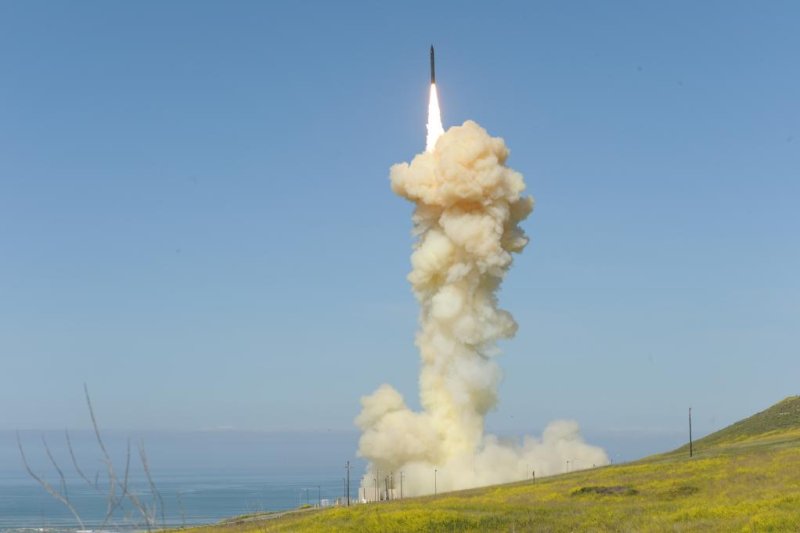1 of 4 | The "lead" ground-based interceptor is launched from Vandenberg Air Force Base, Calif., and successfully intercepted a target launched from the Ronald Reagan Ballistic Missile Defense Test Site on Kwajalein Atoll on Monday. Photo courtesy
Missile Defense Agency
March 26 (UPI) -- The U.S. Missile Defense Agency successfully tested two interceptors against a dummy intercontinental ballistic missile Monday.
The interceptor missiles, which were launched from Vandenberg Air Force Base in California,
shot down a test ballistic missile launched from 4,000 miles away on the Marshall Islands in the Pacific Ocean, the agency said in a news release.
The system is designed to engage and destroy intermediate and long-range ballistic missile threats using Ground-based Interceptors, according to the agency.
"This was the first GBI salvo intercept of a complex, threat-representative ICBM target, and it was a critical milestone," MDA Director Air Force Lt. Gen. Samuel A. Greaves said. "The system worked exactly as it was designed to do, and the results of this test provide evidence of the practicable use of the salvo doctrine within missile defense. The Ground-based Midcourse Defense system is vitally important to the defense of our homeland, and this test demonstrates that we have a capable, credible deterrent against a very real threat."
Two ground-based interceptors, designated as GBI-Lead and GBI-Trail, were used for the test.
The GBI-Lead destroyed the reentry vehicle and the GBI-Trail found the next "most lethal object" and successfully destroyed it.
"They both did what they are designed to do," agency spokesman Mark Wright told KTVA-TV in Alaska, where there are four ground-based interceptors at Fort Greely. "When these vehicles make it to space, there is no air or gravity. The missile sheds various parts as it picks up speed: fuel tanks, clamshells and that sort of stuff. Then you are left with the reentry vehicle, or warhead, if you will. Behind it is all this debris.
"The lead did its job and struck the 'warhead,' and the trail looked through all the debris and hit the next largest target. The identification it made was correct."
Sensors from the space, ground and sea provided real-time target acquisition and tracking data to the command, control, battle management and communication system.
The test was conducted in cooperation with the Joint Functional Component Command for Integrated Missile Defense, U.S. Northern Command, and elements of the U.S. Air Force Space Command's 30th, 50th, and 460th Space Wings.
Officials will evaluate system performance based upon telemetry and other data obtained.
"For years, adversaries like Russia, Iran, North Korea, and China have been accelerating their ballistic missile programs with the goal of creating weapons that can reach the United States," U.S. Rep. Don Young, R-Alaska, who helped secure more than $2.1 billion for Ballistic Missile Defense installations, said in a statement. "If we are to adequately protect our homeland, it is critical that the United States support and expand our ground-based missile defense infrastructure."
The Pentagon is requesting $9.4 billion in fiscal 2020 for agency programs, including $1.4 billion for the ground-based segment, compared with $9.36 billion previously planned, Bloomberg reported.
Boeing manages the $36 billion system, which includes radar, command links and ground-based interceptors. Raytheon is the lead contractor for the kinetic-force kill vehicle, which as part of the intercept component is designed to destroy targets by impact rather than explosives.
"The data collected from this test will enhance missile defense for years to come and solidify confidence in the system," Paul Smith, Boeing vice president and program director for the Ground-based Midcourse Defense, said in a statement. "We continue to increase the system's reliability as the U.S. government plans to expand the number of interceptors protecting the country."
The last successful missile defense tests were in May 2017 and June 2014. Two failed in 2010.
President Donald Trump wants 20 additional interceptors at Fort Greely by 2023, along with missile-detecting radar and sensors. Vandenberg has four ground-based interceptors.















